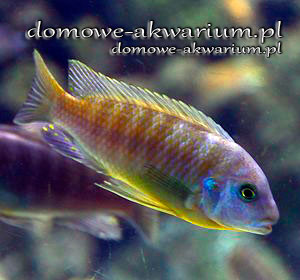
| Species | Fuelleborn's Cichlid |
|---|---|
| Other names | Fuelleborn's Mbuna |
| Latin Name | Labeotropheus Fuelleborni |
| Family | cichlids |
| Origin | Afryka |
| Length | 13 cm |
| Temperature | 24 - 28°C |
| Water Hardness | medium hard - hard |
| pH | 7.5 - 8.5 |
| Aquarium Size | 150 L |
| Food | plant, dry, live, frozen |
Fuelleborn's Cichlid, Fuelleborn's Mbuna
This is a freshwater species, endemic to Lake Malawi in Africa. Its main habitat is shallow, troubled water in the rocky coastal zone.
The fish's coloration is quite variable. The dominant color is blue, with yellow-orange accents around the abdomen, dorsal, and tail fins. There are also marbled varieties, which spots can be brown (usually females), blue or green on a lighter background. A distinguishing feature of this species is the fat bump above its upper lip, which over time completely obscures this lip. It is a protruding, fleshy bulge that from the side looks a bit like a wicked witch's curved nose. It helps the fish to scrape algae off rocks. The male is slightly larger than the female and more colorful, especially during the spawning period. Also, on his anal fin, there are small, oval, yellow spots that mimic the eggs.

Fuelleborn's Cichlid is known for its rather aggressive disposition, especially towards its own species. It is also territorial. These behaviors can be mitigated by having other species present, such as fish of similar size and temperament from the mbuna group (e.g., the yellow cichlid, Johanna's cichlid, Pseudotropheus demasoni, Maylandia estherae, etc.). Effectively, there are three ways to manage aggression among these fishes: the presence of different species, overstocking the tank (within reason), spacious aquarium with lots of hiding places, or stocking with a predominance of females (2-3 females for each male). This is a herbivorous species that readily feeds on algae - avoid high-protein foods. It is intelligent and curious and digs into the substrate. Moreover, males show a tendency to change body coloration under stress or excitement.
The aquarium should be spacious, with a sandy bottom, numerous hiding places among rocks, caves, ravines formed by stones, with open spaces for free swimming. Plants are not recommended - the fish will nibble them. A good filter, regular water changes, oxygen-rich water, and increased water movement are essential.

This species is oviparous. Under proper conditions, fish can reproduce without intervention, in a community tank. Such an aquarium should be appropriately large, equipped with flat rocks, open sand areas, and numerous hiding places for females, with a pH=8.3, temperature of about 26°C (78°F), and hard water. For each male, there should be at least 2-3 females, which all fishes should be approximately of the same age. Fish can be stimulated for spawning by feeding with plant-based feeds or through more prominent and frequent water changes. The male, before starting to spawn, cleans a hard surface on which the eggs will be laid and then brightly colors. At this point, he can be very assertive with females - it doesn't matter to him whether the female is interested or ready to spawn. The encouraged female moves to the site chosen by the male and lays her eggs. She then picks them up in her mouth, and the male fertilizes them. On his tail, fin are light, oval spots that resemble eggs. The male lays his anal fin on the surface where the eggs were before. The female, thinking that they are eggs, tries to collect them in her mouth, and the male at this moment fertilizes the gathered grains. The female holds in her mouth 25-50 eggs. During this period, she does not eat. If stressed or frightened, she might abandon the eggs or even eat them, so it's advised to transfer her gently to a separate tank. After 28 days, fry begin to appear and start to feed. The female cares for the fry for a while.